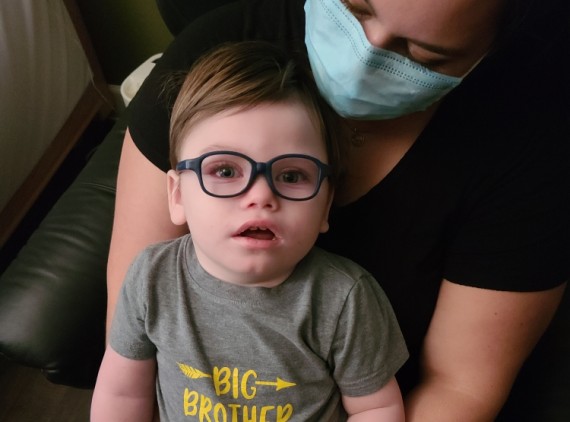- Patient and Family Advisory Council (PFAC)
- Barrow Neurological Institute at Phoenix Children's
- Epilepsy Program
- Genetics & Metabolism
- Neurocritical Care Program
- Neurology
As a trained nurse, Samantha knew something was off when her newborn son Dominic was having feeding issues and wasn’t latching or gaining weight.
“I practically became best friends with our pediatrician,” Samantha says. “We were always at the doctor, always trying different formulas or other things to help Dominic gain weight.”
When Dominic was 2 months old, it looked like he was holding his breath and turning blue. Sometimes, he would become unresponsive. Then one day, daycare called and said they thought he’d had a seizure.
“I knew nothing about pediatric hospitals at the time,” Samantha says. “I had never known anyone who had ever needed those services.”
Dominic was admitted to a local hospital, but when his work-up was fine, he was discharged. During a follow-up appointment with his pediatrician a couple days later, Dominic had three seizures in the doctor’s office. Their pediatrician called 911 and all of a sudden, they were on their way to Phoenix Children’s Hospital.
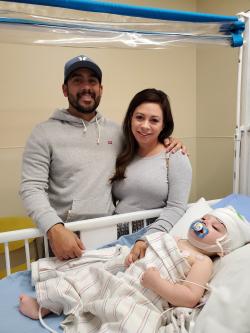
Dominic was admitted to Phoenix Children’s Hospital and stayed for a month as teams of specialists tried different tests and medicines to figure out what was causing his seizures and how to get them under control.
“With complex epilepsy, it can be difficult to diagnosis,” Samantha says. “Even though I’m a nurse, I was scared to take my son home until we knew next steps.”
Dr. Angus Wilfong, division chief of pediatric neurology and associate director of Barrow Neurological Institute at Phoenix Children’s, met with Dominic’s parents and presented a plan that would allow them to safely take Dominic home while he continued to receive outpatient care.
“He explained everything in detail. He made us feel comfortable with the plan before we left the hospital,” Samantha says.
Dominic was ultimately diagnosed with GRIN1, a genetic neurodevelopmental disorder. Children diagnosed with GRIN1 have mild-to-profound developmental delay, and they often have epilepsy, cerebral palsy, feeding difficulties and behavior problems.
“Receiving a diagnosis that you don’t expect can be overwhelming in the beginning. You can feel lost and hopeless,” Samantha says. “Being the parent of a medically complex child can be lonely. Now, I tell other parents to know that you’re not alone. Let your medical team help connect you with other families in similar situations. You can learn a lot from them. They can be your support system.”
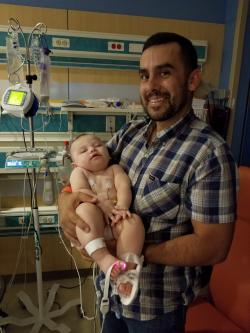
GRIN1 is extremely rare. There were just three other children in the world with the exact gene mutation as Dominic, and less than 150 children worldwide have had a similar mutation. Since the condition is so rare, more research is needed to fully understand its causes, available treatments and potential prognoses for children diagnosed with GRIN1.
Samantha found solace in a Facebook group for other parents of children living with this condition.
“We talked to families as far away as Canada, Italy and Russia, and we knew we were getting more resources and more help from Phoenix Children’s than anyone else. Eventually, the doctors of other families in this group started reaching out to Dominic’s doctors to learn more,” Samantha says. “Dominic’s neurologists, Dr. Wilfong and Dr. Michael Kruer, were willing to try anything that may have helped our son. We felt privileged to have Phoenix Children’s in our backyard. Even if we had flown all over the world, we were still getting the best care close to home.”
Their team’s commitment to out-of-the-box thinking when it came to fighting back against a rare diagnosis gave Samantha peace of mind and reassurance.
One creative treatment that Dr. Kruer suggested was an epidural in Dominic’s spine. A study done in collaboration with Emory University had determined that Dominic’s GRIN1 mutation made him insensitive to magnesium, a mineral that controls electrical activity in the brain. Dr. Kruer teamed up with anesthesiologist Dr. Sean Gamble and the Barrow Neurological Institute at Phoenix Children’s neurocritical care team to make this possible.
“Dominic needed more magnesium in his brain, and so they got creative and administered that via his spinal fluid” Samantha says. “Almost immediately after the injection, we saw a significant improvement in Dominic’s demeanor. We were able to interact with him unlike any other time before. It was truly remarkable to see how calm, happy and chatty our little boy was with us.”
Samantha appreciated the way her son’s doctors and Phoenix Children’s research scientists were committed to creativity when it came to treatment options.
“That is the type of care that makes Phoenix Children’s stand out far above the rest,” Samantha says.
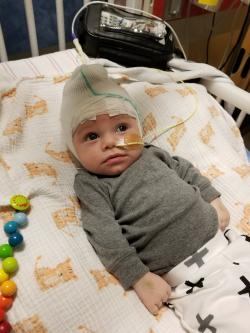
Due to Dominic’s GRIN1 diagnosis, he was not able to meet typical milestones. His frequent seizures, as well as pulmonary and gastrointestinal issues, meant that his family stayed at Phoenix Children’s Hospital for a week or two out of every month in his first year of life. Once, when Dominic was healthy enough, he traveled with his parents to California; his dad was doing a half-marathon in his son’s honor.
“I was so worried to take him on the plane; he had so much equipment and so many medications,” Samantha recalls. “But that was the only vacation we ever took him on, and I’m so glad we did it.”
Dominic loved the outdoors and would instantly relax on walks in his stroller. His parents took him outside as much as they could.
Although the family hoped that someday Dominic would undergo surgery to implant a pump to allow for continuous magnesium delivery to his brain, Dominic was too sick with different viruses and was never healthy enough to undergo the procedure. He passed away in January 2021 when he was 3 years old, a few months after his baby sister Sophia was born.
Dominic’s family donated his brain to the University of Toronto for GRIN1 research. His cord blood and tissue were donated as well. Dominic’s are the first remains worldwide to be donated for research of this condition.
Before Dominic passed away, Dr. Kruer asked Samantha if he could nominate her for the Patient and Family Advisory Council (PFAC) for Barrow Neurological Institute at Phoenix Children’s. PFACs are special groups of patients and family members dedicated to improving care at Phoenix Children’s, who bring unique and valuable perspectives to decisions that affect care, safety and the overall patient experience.
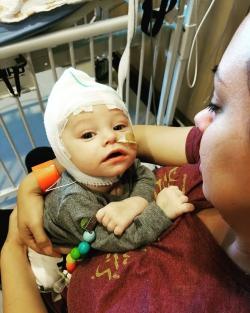
“Phoenix Children’s does an incredible job, but there is always room to improve,” Samantha says. “I bring a unique perspective, being the mother of a medically complex child who has now passed away and being a nurse at another facility.”
In her role on the Neuroscience PFAC, Samantha strives to ensure all families receive the high level of coordinated care that her son received during his time as a patient.
“Dominic had a team of 10 doctors, yet they all collaborated and worked together. That’s the dream,” she says. “From a parent perspective, I felt like Phoenix Children’s was a partner on our journey. I was given so much support and so many resources as a parent. The physicians cared for my son, but they were compassionate toward me as well.”
Samantha is committed to giving back to honor her son and to help other families.
“When you lose your son so early, the only thing you can do is volunteer, give back, donate – whatever you can to help others,” Samantha says. “Phoenix Children’s took amazing care of Dominic, and we will always be grateful.”

